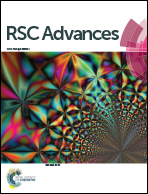Controllable synthesis of Ni3−xCoxS4 nanotube arrays with different aspect ratios grown on carbon cloth for high-capacity supercapacitors†
Abstract
Ni3−xCoxS4 (x = 1.5, 2, 2.25, 2.5) nanotube arrays were prepared on carbon cloth by a two-step hydrothermal route and their electrochemical performance was studied. The aspect ratios and electrochemical performance of the Ni–Co sulfide nanotube arrays can be well controlled by manipulating the Co/Ni molar ratio. With the cooperation of the appropriate morphology and compositions, the specific capacitance of Ni0.75Co2.25S4 can reach as high as 1856 F g−1 at 1 A g−1. The rate capability is 88% at a high current density of 50 A g−1. The superior electrochemistry performance demonstrates that Ni–Co sulfide nanotube arrays with an appropriate molar ratio of Co/Ni would be promising for high-performance supercapacitor materials.


 Please wait while we load your content...
Please wait while we load your content...